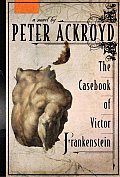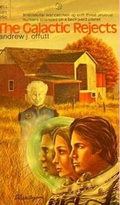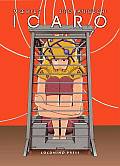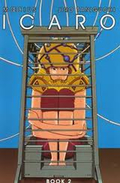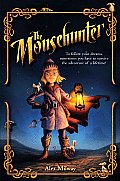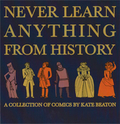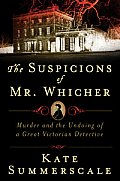Link to this review in the form of a comic strip by geneambaum tagged graphic novel • humor
Link to this review by davidtomashek tagged historical fiction • paranormal
At eighteen, Victor Frankenstein studies natural philosophy at Oxford. He meets Percy Bysshe Shelley and the two men become inseparable, talking for hours about ideals and visions for humanity’s future. Shelley seeks to reinvent man through poetry, philosophy, and social action. Victor becomes intrigued with the uses of the newly discovered galvanic energy on living tissue.
After his father dies, Victor inherits a small fortune and sets up a laboratory in a warehouse in a run-down area along the Thames. Victor has no trouble procuring bodies for his experiments from men who make a living robbing graves for the medical establishment. Victor reanimates simple body parts at first, and finally creates a powerful and dangerous creature. It flees the laboratory but is never far away, bringing misery to Frankenstein and the people he loves, including Shelley and his young wife.
Why I picked it up: Reworkings of Frankenstein always intrigue me (I have one of my own to write someday). I wanted to see how this story would diverge from the original, and if there would ever be reconciliation between Victor and his creature.
Why I finished it: The book is full of history, from the lives of Shelley and Byron to the living conditions in 18th century London.
I’d give it to: My former co-worker, Allen, who loves the Richard Sharpe novels and how they intermingle history and fiction.
Link to this review by billba tagged science fiction • paranormal
Psychic individuals are an important part of humanity’s war against the Azuli. But three are on their way back to earth, rejected as useless. Corisande is telekinetic, but she’s a brat. Berneson can teleport, but he thinks only of himself. Rinegar can read minds, but his spirit was broken when he lost his wife in the war. Then their shuttle is destroyed and they are stranded on a primitive world. They are just starting to make a home for themselves as circus performers when the Azuli threaten their adopted planet.
Why I picked it up: I loved this book as a boy, but as an adult I could never remember anything more than the plot. Then Unshelved Answers came to my rescue and Gene bought me a copy.
Why I finished it: The writing is a little stiff, the characters a little cardboard-y, but true to my memory the plot just rollicks along, with three heroes pitted against an entire invasion army.
I’d give it to: My son Theo, who will root against the bad guys and then spend a few weeks debating which power would be the most fun to have.
Link to this review by geneambaum tagged science • romance • graphic novel
In a world where test tube humans rebel by becoming self exploding suicide bombs, a woman gives birth to a boy who can fly. Code named Icaro, the government orders him kept secret and isolated from the outside world. Scientists analyze him for twenty years, and he is a very compliant test subject. But he develops feelings for a young researcher. After she’s removed from the project, Icaro escapes from the garden where he’s kept in an effort to see her. The government, determined to use Icaro against the rebels, may resort to brain surgery to ensure his compliance.
Why I picked it up: I read the first book because it was written by Moebius, but never saw the second volume until a recent trip to Powell’s.
Why I finished it: This story amazed me on a more visual level — the art conveyed a sense of wonder at Icaro’s abilities. I also really enjoyed Taniguchi’s A Distant Neighborhood Volume 1 last year, which is also (though less obviously) science fiction.
I’d give it to: Silver, because she loves Terry Moore’s Echo. Both artists use similar lines, despite recognizably different styles. And both draw hair and flying humans with an appropriate sense of wonder. D. in Texas, because he’d enjoy the beautiful naked women and the inexplicable, semi-perverse sexual moments that suddenly appear in the story in a few places.
Link to this review by geneambaum tagged fantasy
Twelve-year-old Emiline looks after the mouse collection of Isiah Lovelock, author of The Mousehunter’s Almanac and one of the wealthiest men in Old Town. Lovelock puts a bounty on the notorious Captain Mousebeard, with a bonus for the return of the mice in his beard. Lovelock then commissions Captain Drewshank to go after the pirate. Emiline makes a decision: she’s going with Drewshank. But to earn her place in his crew, she needs to take care of the ship’s problem mouse, a vicious Sharpclaw.
Why I picked it up: My daughter is a sucker for books featuring girls and animals.
Why I finished it: There was enough nastiness to make it a great read bedtime aloud for both of us. The adults are indifferent and occasinally cruel. As the plot moves past the anticipated encounters with Mousebeard and his ship, the Silver Shark, into unexpected territory, Emiline has to survive by her wits, using her knowledge of highly specialized mice to her direct advantage or to make herself valuable. My favorite: the dung mouse. (For Halloween, she’s going to be Emiline and I’m going to be Mousebeard.)
I’d give it to: Colette, in my daughter’s class, who liked The Mysterious Benedict Society and Emmy and the Incredible Shrinking Rat. Selena, whom I went to high school with, and whose rats used to lick the salt off my fingers, would love Emiline’s relationship with her pet Grey Mouse, Portly.
Link to this review by sarahhunt tagged humor • historical fiction • comic strips
A collection of Beaton’s comic strips, originally published on her website, Hark! A Vagrant. Most involve historical and literary figures in amusing and (mostly) accurate situations, all with flaws like people you know.
Why I picked it up: I started reading Beaton’s strips online after she was recommended by another writer I follow. I bought the book because I look forward to her new strips and want to support independent artists.
Why I finished it: It’s like the best sitcom, but with people you’ve read about instead of wacky neighbors. The faces of her characters are really expressive even though they are simple line drawings. And as an extra bonus, lots of Canadian history!
I’d give it to: Jen, who likes literature and celebrity gossip, and this is both. I hope the next collection has this one in it, just for her.
Link to this review by flemtastic tagged fantasy
Digger, a gifted thief, enjoys her life and loves Tegen, her partner in crime. On a routine job, Tegen is killed by the King’s Greenmen. Injured, Digger escapes, but she has no place to hide. She comes across a boatload of drunken teen nobles and, after inventing a fake name and background, accompanies them to their country estate to serve as a lady’s maid. The noble family appears to be fomenting revolution against the oppressive King, who roots out magic through fear and executions. Things turn explosive when Digger discovers an injured Prince hiding from assassins in the tunnels below the castle.
Why I picked it up: I’m always on the lookout for fantasy with a strong female lead. Also, Bunce’s A Curse Dark as Gold won her an award for best debut book, so this was worth checking out.
Why I finished it: Magical abilities bring a death sentence, yet Digger has successfully hidden her talent to see magic, and can perceive a different type in the young lady she serves. There is no way that magic users will be eliminated, is there? Politics and intrigue abound, motivations (i.e. blackmail!) being very clear. I was very invested in the crises that Digger faced at every turn.
I’d give it to: Michelle, who devoured Robin Hobb’s Assassin’s Apprentice trilogy, because characterization is a strength the two authors share. The density of the subject matter makes this similar to George R.R. Martin’s A Song of Ice and Fire, though it is accessible to a younger audience.
Link to this review by emilyjones tagged mystery • historical fiction • audiobook
In 1860, murder wasn’t discussed in polite society. But in the English countryside, Mr. Whicher, one of Scotland Yard’s eight original detectives, needed to solve the horrifying murder of a 3-year-old. Invasive, new-fangled investigative techniques like collecting evidence (including undergarments!) and interviewing the victim’s family and neighbors defied social norms in the quaint English village where the crime took place.
Why I picked it up: I am a hardcore fan of Simon Vance. I’d listen to him reading IRS forms. Plus there’s an over-the-top, backlit haunted house on the cover of a nonfiction crime title. Sold.
Why I finished it: I couldn’t get over how manners and social class interfered with police procedure. I can’t imagine asking a detective to leave my home because the line of questioning was too intrusive. It was also fascinating to hear how this case eventually caught the public’s attention, giving birth to a new breed of armchair sleuths and media sensationalism.
I’d give it to: People who prefer nonfiction that reads like fiction, and anyone who wants to be read to by a Brit (sigh).


